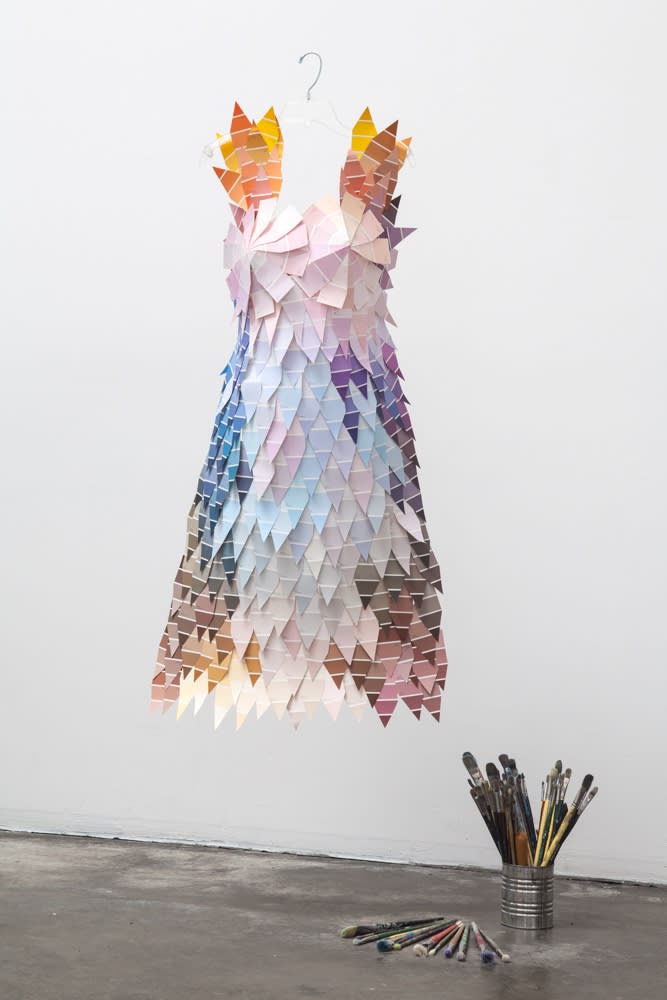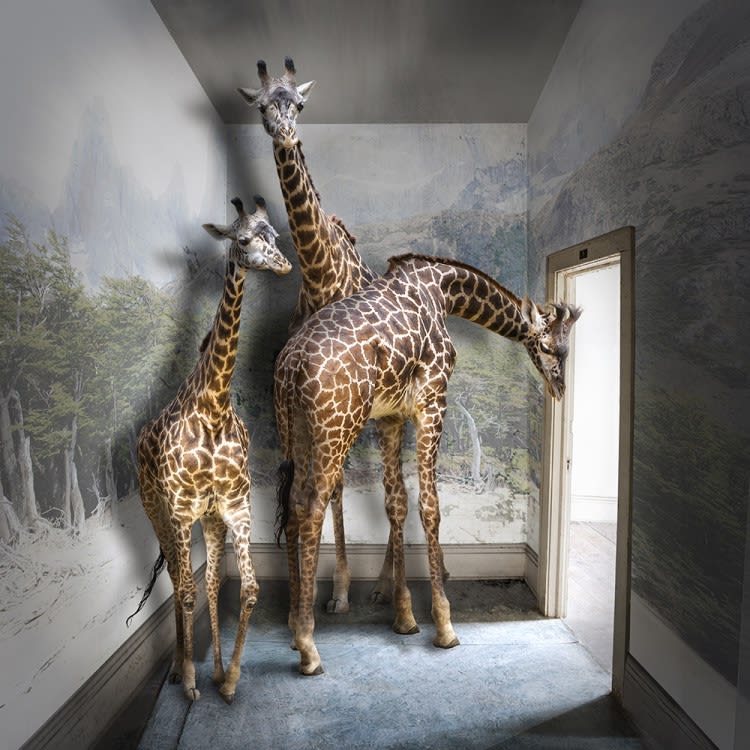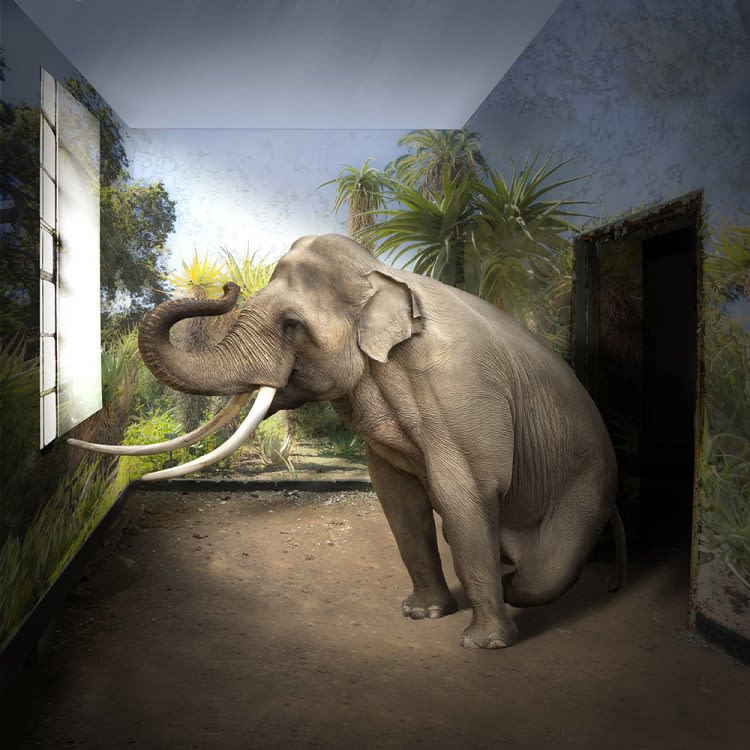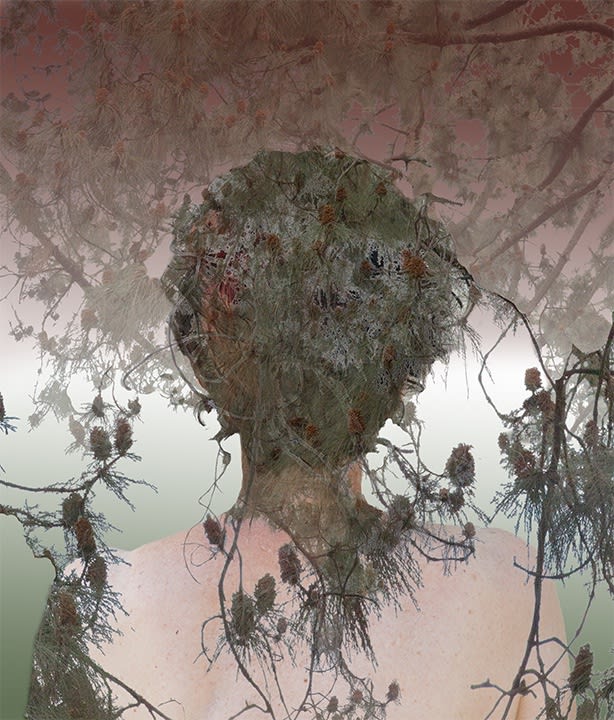
This is Part 2 of a Commentary of my review work at The Medium Festival of Photography in San Diego, California during late October 2015. Part 2 discusses selected non-traditional work by four very creative and experimental photographers. The work takes photography into regions that have roots in the past, but grow in creatively new directions. There are staged, constructed narratives, fanciful imaginative settings, photo collaged images, and artists combining an assortment of drawn pictures with photography and other media.
Jane Szabo is a young energetic photographer that creates a staged performance, and constructed environment, to take the viewer into an examination of “Self”. She had two series of works. One is “Sense of Self” in which she either Grids the environment or “grids” herself with tape, that then deconstructs. It seems a representation of how we try to construct and maintain a stable environment around us, but sometimes, things weaken or come apart. It very much struck me as a great visual representation of our mental states and moods that occur to different degrees in all of us each day or over time.

Her second series was “Reconstructing Self”. These photographs are constructed dresses of various materials. In each, the constructed garment hangs next to materials that are part of, or items symbolic of, the dress construction. Szabo explains this series in an excerpt from an interview in Silvershotz (Volume 9, Edition 6) she suggested: “Though I think deeply about the ideas behind the project while it is in the planning stages, when I am in the studio doing the actual fabrication I work intuitively. I start with the material, and do not arrive with a drawing or a preconceived notion of what the finished product will really look like. I might have a vague idea, but the actual form is developed and realized in the act of making as I respond to the physicality of the materials. Some materials want to bend or drape a certain way, and I celebrate those nuances that lead to the finished product. I am not a fashionista nor do I sew. These dresses spring from my background as a model and miniature builder and my experience of working in the film and television industry.”

“Animal Intentions: Portraits of Animals in Captivity” by photographer Carol Erb triggered a joyful sense of fantasy and childhood exploration for me. With photography, we are often confronted with our reality in front of the lens, often harsh. Erb states that: “Like most people, my fascination with animals began in early childhood. Zoo visits and circus shows. Stuffed animals lined the shelves of my bedroom. Storybooks were filled with benign and friendly creatures.We humans have very complex psychological relationships with animals. …My series explores our human compulsion to take animals out of their natural environment and create fictional personas and habitats, far removed from reality.” The images give us a fun exploration like reading a children’s story with a serious undertone that doesn’t overwhelm us.


I am very much attracted to creative expression in the use of images. Sandra Klein combines photographs to create images in her “Shinrin Roku” series that blend ourselves into the natural environment. In her artist statement, Klein describes the images: “While traveling in Japan, I experienced what the Japanese call Shinrin Roku or “forest bathing”, a term that refers to the healing power of nature. This act of aligning with nature dramatically altered my photographic vision. Originally a printmaker, I have always constructed my layered photographic images out of a wide variety of sources, … This series has two parts, the images I captured in Japan and then complimentary self-portraits that reflect my physical self in the midst of experiencing Shinrin Roku.”

I think many artists have tried to combine self and our environment. Jerry Uelsmann is one who has mastered complex combinations of images in a non-photoshop way. Klein is different in that its specific to a country foreign to her background, using photography to reach across borders to bring the viewer engagement with a different culture.

Photography and drawings are combined into a “hybrid still life” by Randi Ganulin to illustrate to the viewer natural disasters in “Vessels: Environmental Parables”, and a series on healing and rebirth called “Inanna”. In the Vessels series, Ganulin is making a visual statement of such disasters as the BP Oil Spill in the Gulf of Mexico in 2010, the Fukushima Japan tsunami and nuclear plant crisis of 2011, and issues of global warming’s impact on the oceans. Observing the image, the viewer is drawn into looking at multiple images, some drawn, some photographic, that capture, as in “Teapot”, the symbolism of changing global temperatures, and the impact of polar ice caps, sea life and rising oceans.

Ganulin sets the foundation of the “Inanna” series in the ancient Sumer civilization legend of a goddess that travels to an underworld, and is reborn. This rebirth is symbolic of her expression of healing processes and challenges in and of life. Her challenges of like invoice expression of enduring illness, adoption, and faith. In her description of Gale Force, Ganulin states: “… in Gale Force, I subvert the religious gesture of Da Vinci and Koons’ “John the Baptist”, and turn it into a goddess-centric environment protest…”.

Each of these four artists, in their own unique way, create an environment, a performance, and a mix of images and/or media. Each uses the camera, not to capture a record of our surroundings in front of the lense, but as a tool to create a narrative and statement. The narrative is not describing what can be seen by any viewer standing beside the photographer, but a window into a dialogue about some topic the artist is concerned about. That topic ranges from internal struggle to external impacts by mankind on our environment. Each to me is artistic expression. Each is photographic. Each is a unique expression.
All images presented with the permission of the photographer
